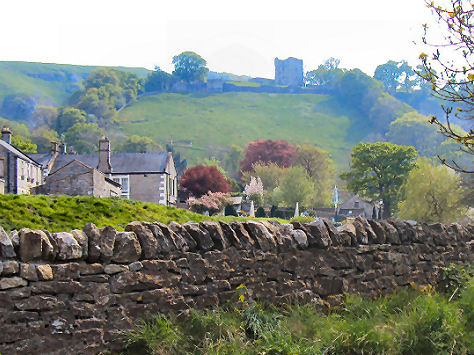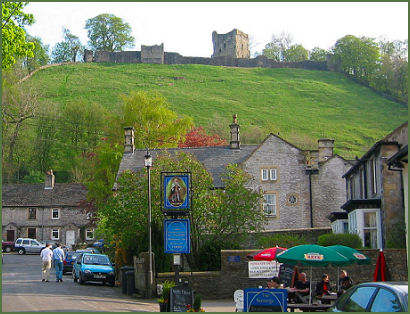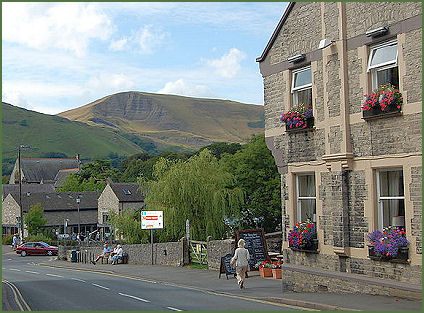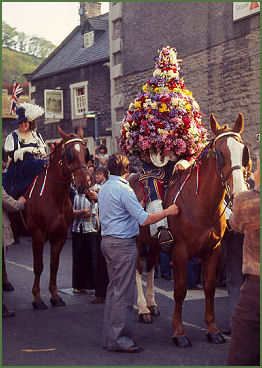Castleton
Grid Ref:
 The popular village of Castleton, steeped in a rich heritage and tradition, is situated at the western end of the Hope Valley in the Peak District National Park.
The popular village of Castleton, steeped in a rich heritage and tradition, is situated at the western end of the Hope Valley in the Peak District National Park.
An ancient settlement with a long history, the village was recorded as Pechesers in the Domesday Book of 1086 where "Arnbiorn and Hundingr held the land of William Peverel's castle in Castleton. Early settlement in the area was at the Iron Age fort at the summit of Mam Tor, although it is thought that the there was settlement in the Bronze Age (around 1,400 BC). Even earlier traces of Stone Age man have been discovered in some caves on Treak Cliff, less than a mile from the centre of Castleton.
Peveril Castle stands imposingly on a limestone outcrop above the village and dominates the surrounding landscape. The castle (pictured above left and below right) was founded by William Peverel (c. 1040–circa. 1115) a Norman knight, who was granted extensive lands in Derbyshire and Nottinghamshire by King William I in reward for supporting him during the Norman Conquest of England. Peverel is thought to have been the illegitimate son of William the Conqueror although this claim rremains unsubstantiated. The castle layout is roughly triangular, measuring about 90 metres by 65 metres (300 feet by 213 feet). The land slopes steeply away from the castle's perimeter, almost forming a sheer face to the south east. The winding approach from the north marks the most practical approach to the castle. The keep dates to around 1176 and was built by King Henry II, England's first Plantagenet monarch.
 Other interesting older buildings in the village are the Castle Hotel, which dates back to the seventeenth century, and Castleton Hall, a fine seventeenth house, which now serves as a Youth Hostel.
Other interesting older buildings in the village are the Castle Hotel, which dates back to the seventeenth century, and Castleton Hall, a fine seventeenth house, which now serves as a Youth Hostel.
 The Peak Cavern, also known as the Devil's Arse, is a large show cave in the village. Unlike the other show caves in the Castleton area, Peak Cavern is almost entirely natural, the only artificial part of the cave was blasted through to bypass a low tunnel which was only accessible by lying down on a boat. The cave is the largest in the Peak District, and its main entrance, measuring 102 feet wide and 60 feet in height, is the largest cave entrance in Britain. The main entrance is situated down a steep gorge in Castleton village, that has 280 feet high vertical cliffs.
The Peak Cavern, also known as the Devil's Arse, is a large show cave in the village. Unlike the other show caves in the Castleton area, Peak Cavern is almost entirely natural, the only artificial part of the cave was blasted through to bypass a low tunnel which was only accessible by lying down on a boat. The cave is the largest in the Peak District, and its main entrance, measuring 102 feet wide and 60 feet in height, is the largest cave entrance in Britain. The main entrance is situated down a steep gorge in Castleton village, that has 280 feet high vertical cliffs.
Castleton boasts four underground show caves, the others are are the Blue John Cavern, Speedwell Cavern, and Treak Cliff Cavern. Blue John Cavern and Treak Cliff contain the highly attractive blue and yellow fluorspar known as Blue John. It was first mined at Treak Cliff and by 1770, 16 mines were extracting the stone and selling it to several firms in Derbyshire who turned it into ornaments, vases, clocks and jewellry. Blue John is only found in this area of Britain, and small pieces of the mineral are still plentiful, large pieces are now rare. Jewellery and ornaments made from Blue John may be found in the plentiful souvenir shops in the village.
Castleton attracts large numbers of tourists, there are many pubs, guest houses and tea shops. The village has a large visitor's car park, a variety of gift shops and a youth hostel. Castleton also has an interesting visitor centre with audio-visual displays. The main centre for visitors exploring the Hope Valley, it houses the Castleton Village Museum and many local treasures, some dating from prehistoric times. Visitors are inspired to discover the delights of Castleton and the Hope Valley through interactive and interpretative displays.The centre received a silver award in the East Midlands Enjoy England Excellence 2008 awards for the quality of its tourism information services


The village church, St Edmund's, stands at the heart of the village, the building is of Norman origin and was built before the year 1200, although a church has occupied the site since Saxon times. It may have been originally been constructed as a garrison church to Peveril Castle, the building features a broad Norman chancel arch and a pinnacled tower. Inside are some interesting examples of early medieval stained glass, the font, the base or plinth of which is Saxon, the top Norman. There are also some fine seventeenth century box pews, (many of the pews still have the names of the people who owned them carved into the woodwork) and a valuable Breeches Bible dating to 1611.
Oak Apple Day
 The ceremony of Oak Apple Day is still celebrated in Castleton, Royal Oak Day was a public holiday celebrated in England each 29th May to commemorate the restoration of the monarchy, under King Charles II in May 1660.
The ceremony of Oak Apple Day is still celebrated in Castleton, Royal Oak Day was a public holiday celebrated in England each 29th May to commemorate the restoration of the monarchy, under King Charles II in May 1660.
“Parliament had ordered the 29th of May, the King’s birthday, to be forever kept as a day of thanksgiving for our redemption from tyranny and the King’s return to his Government, he returning to London that day."- Samuel Pepys Diary 1st June 1660'.
Oak Apple Day, was formally abolished in 1859, Castleton is one of the few remaining places where the tradition is still adhered to. Traditional celebrations to commemorate the event often entailed the wearing of oak apples or sprigs of oak leaves, in reference to the occasion after the Battle of Worcester in September 1651, when the future Charles II escaped the Roundhead army by hiding in an oak tree near Boscobel House. The ceremony is perhaps a continuation of pre-Christian nature worship.The Garland King who rides through the streets of Castleton, completely disguised in a garland of flowers, which is later affixed to a pinnacle on the parish church tower, has little connection with the Restoration, though he dresses in Stuart costume. He is perhaps a kind of Jack in the Green and the custom may have transferred from May Day.
The Garland worn by the king is around a metre high and made from a wooden frame, wound with string to which small bunches of wild flowers and leaves are attached. A further small wreath, called the `Queen` is made from choice garden flowers and is placed on top. Just before the start of the ceremony the garland is lifted onto the shoulders of the `King'. After touring the streets of the village on horseback accompanied by his consort, a procession and a band, the King is relieved of his Garland which is then hoisted up to the top of the tower of St Edmunds Church. The Queens wreath is placed by the village war memorial and in the market place there is Morris dancing and singing.
Castleton village museum contains an interesting display of Garland memorabilia which includes an outfit worn by a King 200 years ago.
Nearby places of interest
Treak Cliff Cavern is a show cave of international fame and geological importance, located on the Old Mam Tor road near Castleton.
Winnats Pass a dramatic ravine, lying just to the west of Castleton.
Animal Farm is a conservation farm park based just outside Castleton. The Farm, which makes an interesting and enjoyable place to visit, provides a home for British farm animals which face extinction and a wonderful opportunity for you to meet them.
Eldon Hole is deepest pothole in Derbyshire and is situated on the southern side of Eldon Hill, which lies four kilometres to the southwest of the village of Castleton.
The Chestnut Centre Conservation and Wildlife Park is set in 50 acres of landscaped grounds and is home, not only to a unique collection of birds and animals, but to many wild birds and mammals. The centre contains one of Europe's largest gathering of otters, 16 species of owls and other indigenous wildlife all in their natural surroundings including, buzzards, pine martens, polecats, red foxes, Scottish wildcats and deer.
Navio Roman Fort is situated on a bluff overlooking the confluence of the River Noe to the west of the hamlet of Brough in the Hope Valley.
Back to Top